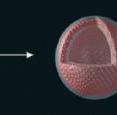Bristly spheres as capsules
Amphiphilic molecules, which have one water-friendly (hydrophilic) end and one water-repellant (hydrophobic) end, spontaneously aggregate in aqueous solutions to make superstructures like capsules or bilayers. This phenomenon is responsible for the effects of detergents and soaps. Dirt is enclosed in little capsules of surfactant, which makes it water-soluble. Cell membranes are also based on this principle: they are simply lipid bilayers, an aggregation of lipid molecules that line up with their hydrophobic tails all together and their hydrophilic heads protruding into the aqueous environment. As reported in the journal Angewandte Chemie, researchers at the Universities of Hamburg and Freiburg (Germany) led by Horst Weller and Stephan Förster have now produced amphiphilic hybrid particles made of a water-insoluble inorganic nanoparticle at the core surrounded by a bristle-like layer of hydrophilic polymer chains. The inorganic nanoparticles are made of cadmium selenide and cadmium sulfide. Polyethylene oxide chains are attached to the nanoparticles through amino groups. The nature of the superstructures formed in aqueous solution depends on how densely the surfaces of the little spheres are covered with the polymer "bristles". If they are densely packed, the hybrid particles remain in solution as individuals, because the bristles repel each other. If the bristles are less dense, dimers and trimers are formed; still sparser bristles result in long wormlike aggregates of many particles that grow into a network through occasional Y-shaped branches. For the particles to aggregate in this way, the bristles on the surfaces of the inorganic cores have to reorganize significantly: they move aside a little to free up points of contact so the cores can attach to each other. Aggregation then continues until the resulting ensemble of cores is, as a whole, surrounded by a sufficiently dense layer of bristles, which acts as a shield toward additional particles.
Cores with an even smaller number of polymer bristles aggregate into extended curved layers that close themselves off into capsule-shaped vesicles. The walls of the vesicles consist of a monolayer of the bristly particles.
The polymer-coated spheres offer a new, simple method for the controlled production of superstructures. The vesicles could be used to encapsulate drugs, for example, as contrast agents, or as ordered liquid crystalline phases for the production of nanostructured hybrid materials.
Source: Wiley-Blackwell
Other sources
- Nanotechnology: Bristly Spheres As Capsules for Drugsfrom Science DailyMon, 9 Mar 2009, 16:50:19 UTC
- Bristly Spheres as Capsulesfrom PhysorgFri, 6 Mar 2009, 15:19:40 UTC
